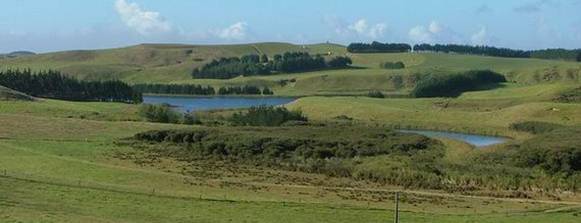9.7 Case study 1:Weeds in Lake Swan
Introduction
Lake Swan is 17.4 hectares with a maximum depth of 5.5m, situated near the bottom of the Pouto Peninsula. There is no public access to the lake. The lake has been fenced off to exclude stock and the majority of the lake margin is surrounded by a dense fringe of Eleocharis sphacelate and raupo (Typha orientalis). Water quality data collected from Lake Swan indicates a mesotrophic status (good water clarity, low nutrient and chlorophyll α concentrations).
The problem with this lake is that it is severely impacted by exotic weeds. Prior to the introduction of oxygen weed (Egeria densa) and hornwort (Ceratophyllum demersum), the lake was dominated by charophyte meadows and the tall-growing native pond weed Potamogeton ochreatus. In March 2005, NIWA resurveyed the lake and concluded that 70% of the lake is now covered by hornwort with the remainder covered by surface- reaching beds of oxygen weed.

Vegetation changes
E. densa (oxygen weed) was first recorded in the lake in 1992. In 2001 the oxygen weed had formed dense beds up to 2.5m tall and occupied most of the lake from a depth of 0.6m to 4.2m.
Hornwort was first discovered in 2005 and had already taken over most of the lake including areas previously occupied by E. densa. Hornwort can grow in water depths up to 10m, so could easily grow throughout the entire lake. Hornwort grows to an average height of 2.3m in Lake Swan. Both plants reach the surface in parts of the lake and form dense beds.
Water quality
Water quality monitoring has been carried out on five occasions, the first being in 1990. No change has been observed in water clarity, pH and chlorophyll α since 1990. However there has been a slight decrease in nutrient levels which is expected with increased macrophyte growth.
Stratification occurs during summer causing anoxia (deoxygenation) of the bottom water with an associated release of nutrients from the sediment. Water clarity, nutrient and chlorophyll α (algal biomass) data indicate a mesotrophic status.
The problem
Vegetation collapse is the greatest threat to Lake Swan at present. Overnight oxygen depletion is already likely to occur in the dense vegetation beds, which will eventually cause the plants to die. Water quality is expected to deteriorate if the lake flips from a macrophyte-dominated into an algal-dominated lake. This would probably deem the lake unusable for humans and stock as toxic algal blooms would be likely. This would also be visually unappealing.
Lake Swan is the only source of hornwort on the Pouto Peninsula and is only a few hundred metres away from Lake Humuhumu, which is one of the most pristine lakes in the area. Hornwort could easily be spread into Humuhumu and other lakes unless care is taken to prevent the spread.
The eradication of the hornwort and E. densa is needed to prevent the spread of New Zealand's worst submerged weed and to prevent water quality degradation in Lake Swan.
Solution
A Community Pest Control Area (CPCA) has been established for Lake Swan to eliminate both hornwort and E. densa. The CPCA programme has been developed to assist groups of land occupiers committed to protecting economic, biodiversity and/or cultural values of a defined area.
As part of this programme, monitoring will be undertaken to assess the effectiveness of the method chosen to control these two weed species. It will be the landowner's responsibility to monitor who is entering the lake and making sure they remove any weed from boats, nets and other equipment used in the lake.
After discussions with landowners, local Iwi and other interested parties, it was decided that grass carp would be used to eradicate hornwort and E. densa. Spraying the weeds with herbicide was an option that was rejected by landowners and iwi who did not want to use chemicals in the lake.
